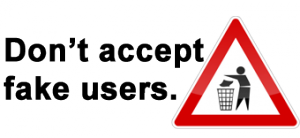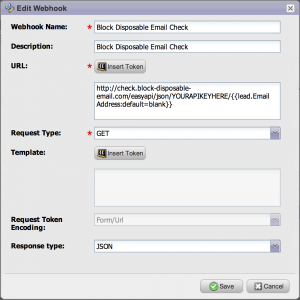Webhooks are user-defined HTTP callbacks. They are usually triggered by some event, such as a sign-up of a new user to a website or a comment being posted to a blog. When that event occurs the source site makes an HTTP request to the URI configured for the webhook – like to the BDEA api. Users can configure them to cause events on one site to invoke behaviour on another. The action taken may be anything like refusing or showing up a specific message to a user that tries to use a disposable email address.
Example
This is a specific example of a software vendor to sort out trial users providing a disposable email address.
They use Marketo’s standard web hook and use Response Mapping to map domain_status to a field in Marketo. Using the web hook as part of the Flow for a Campaign they check for the updated field prior to putting into a trial program. If the response is “block” they divert them from their trial and send an email that basically says they would love to help you out, but please provide a real email.
This is the screenshot of the setup with the API key removed:

